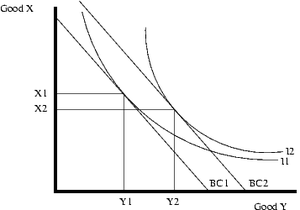Inferior good
In economics, an inferior good is a good whose demand decreases when consumer income rises (or demand increases when consumer income decreases),[1][2] unlike normal goods, for which the opposite is observed.[3] Normal goods are those goods for which the demand rises as consumer income rises.[2][4]

Inferiority, in this sense, is an observable fact relating to affordability rather than a statement about the quality of the good. As a rule, these goods are affordable and adequately fulfill their purpose, but as more costly substitutes that offer more pleasure (or at least variety) become available, the use of the inferior goods diminishes.
Depending on consumer or market indifference curves, the amount of a good bought can either increase, decrease, or stay the same when income increases.[2]
Examples
There are many examples of inferior goods. A number of economists have suggested that shopping at large discount chains such as Walmart and rent-to-own establishments vastly represent a large percentage of goods referred to as "inferior". Cheaper cars are examples of the inferior goods. Consumers will generally prefer cheaper cars when their income is constricted. As a consumer's income increases, the demand of the cheap cars will decrease, while demand of costly cars will increase, so cheap cars are inferior goods.
Inter-city bus service is also an example of an inferior good. This form of transportation is cheaper than air or rail travel, but is more time-consuming. When money is constricted, traveling by bus becomes more acceptable, but when money is more abundant than time, more rapid transport is preferred. In some countries with less developed or poorly maintained railways this is reversed: trains are slower and cheaper than buses, so rail travel is an inferior good.
Certain financial services, including payday lending, are inferior goods. Such financial services are generally marketed to persons with low incomes. People with middle or higher incomes can typically use credit cards that have better terms of payment or bank loans for higher volumes and much lower rates of interest.[5]
Inexpensive foods like instant noodles, bologna, pizza, hamburger, mass-market beer, frozen dinners, and canned goods are additional examples of inferior goods. As incomes rise, one tends to purchase more expensive, appealing or nutritious foods. Likewise, goods and services used by poor people for which richer people have alternatives exemplify inferior goods. As a rule, used and obsolete goods (but not antiques) marketed to persons of low income as closeouts are inferior goods at the time even if they had earlier been normal goods or even luxury goods.
Others are very inconsistent across geographic regions or cultures. The potato, for example, generally conforms to the demand function of an inferior good in the Andean region where the crop originated. People of higher incomes and/or those who have migrated to coastal areas are more likely to prefer other staples such as rice or wheat products as they can afford them. However, in several countries of Asia, such as Bangladesh, potatoes are not an inferior good, but rather a relatively expensive source of calories and a high-prestige food, especially when eaten in the form of French fries by urban elites.[6]
Giffen goods
A special type of inferior good may exist known as the Giffen good, which would disobey the "law of demand". Quite simply, when the price of a Giffen good increases, the demand for that good increases. This would have to be a particular good that is such a large proportion of a person or market's consumption that the income effect of a price increase would produce, effectively, more demand. The observed demand curve would slope upward, indicating positive elasticity.[7]
Giffen goods were first noted by Sir Robert Giffen. It is usual to attribute Giffen's observation to the fact that in Ireland during the 19th century there was a rise in the price of potatoes. The explanation follows that poor people were forced to reduce their consumption of meat and expensive items such as eggs. Potatoes, still being the cheapest food, meant that poor people started consuming more even though its price was rising. This phenomenon is often described as "Giffen's Paradox". However, it has been noticed that Giffen did not use potatoes as an example of Giffen goods.[8] Moreover, potatoes were not Giffen Goods during the Great Famine in Ireland.[9] Alfred Marshall's explanation of Giffen's Paradox was presented in terms of bread.[10]
See also
References
- Mankiw, N. Gregory, Principles of Economics, South-Western Cengage Learning, 2012, p.70
- Varian, Hal R. (2014). Intermediate microeconomics : a modern approach (Ninth ed.). New York: W. W. Norton. p. 96. ISBN 9780393919677. OCLC 879663971.
- "Economics A–Z: Inferior goods". The Economist. Retrieved 17 August 2016.
- O'Sullivan, Arthur; Sheffrin, Steven M. (2003), Economics: Principles in Action, Upper Saddle River, New Jersey 07458: Pearson Prentice Hall, p. 87, ISBN 0-13-063085-3CS1 maint: location (link)
- "Payday Lending in America". The Pew Charitable Trusts. 18 July 2012. Archived from the original on 23 April 2016. Retrieved 28 July 2015.
- Scott, G.J.; Bouis, H.E., "Sustainability of Potato Consumption in Developing Countries: The Case of Bangladesh", Program Report 1995–1996, International Potato Center, archived from the original on 8 April 2010CS1 maint: unfit url (link)
- Varian, Hal R. (2014). Intermediate microeconomics : a modern approach (Ninth ed.). New York: W. W. Norton. p. 104. ISBN 9780393919677. OCLC 879663971.
- Stigler, George J. (1947). "Notes on the History of the Giffen Paradox". Journal of Political Economy. 55 (2): 152–156. doi:10.1086/256487. ISSN 0022-3808. JSTOR 1825304.
- Dwyer, Gerald P.; Lindsay, Cotton M. (1984). "Robert Giffen and the Irish Potato". The American Economic Review. 74 (1): 188–192. ISSN 0002-8282. JSTOR 1803318.
- Marshall, Alfred (1949). Principles of Economics. New York: Macmillan. p. 132.